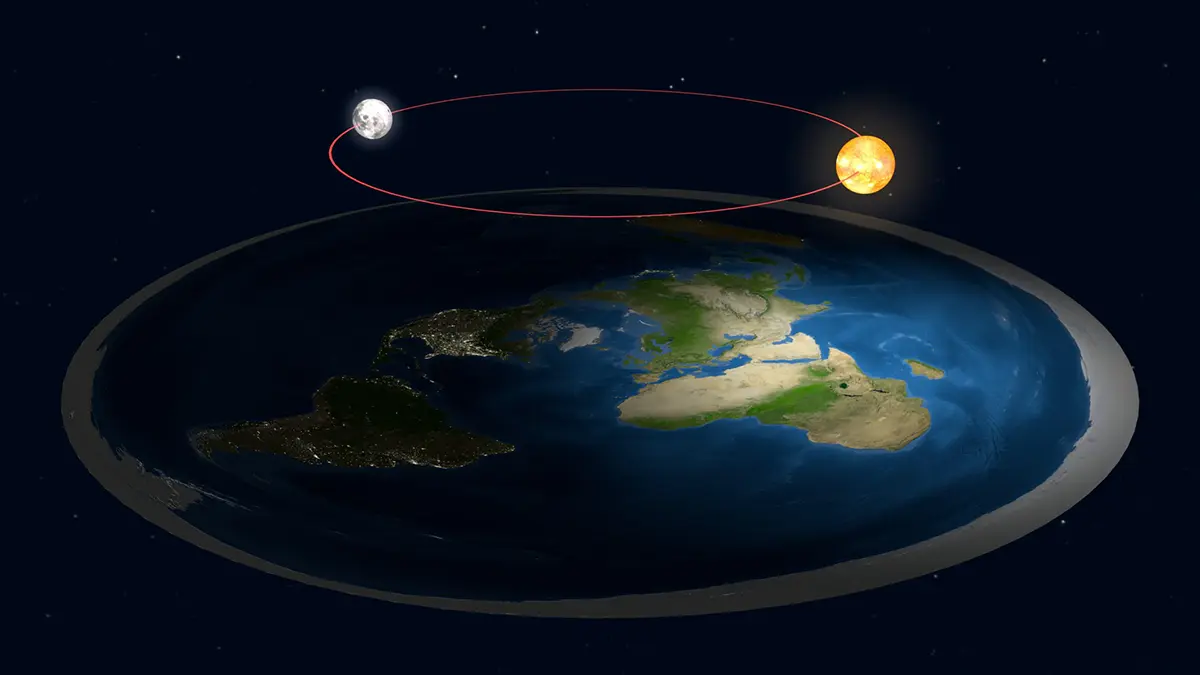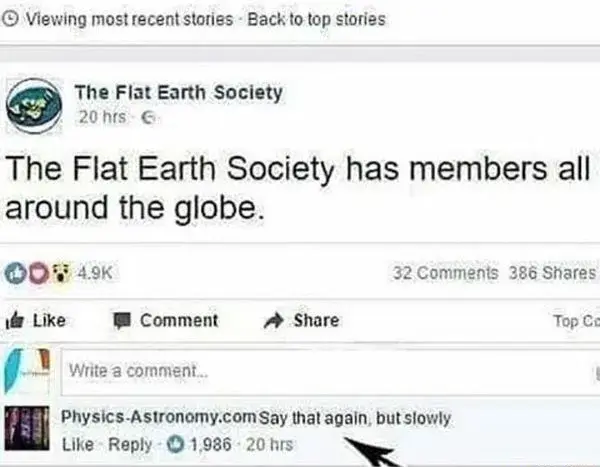
Against the background of declining confidence in the elites—be they political, religious or scientific—the flat earth theory has lately been revived and promoted by a wave of fake news and misinformation that circulates on social media. Unfortunately, it has been noted that many Christians have become swept up in this trend, using shaky theology to argue their points. For Christians who claim that the Earth is flat, a single Bible verse is considered superior to any number of scientific arguments.
In response to the concerning trend we see here, this article will focus on some of the Bible verses most frequently referenced by Christian proponents of the flat earth theory. There are teachers and theologians who have carefully analysed the subject and their conclusions are worth the attention of honest and open-minded Christians investigating this topic. Two such men are Dr Danny Faulkner, a creationist who specializes in mathematics and physics and has a PhD in astronomy, and Dr Randal Younker, professor of Archaeology and History of Antiquity at Andrews University, USA.
the four corners of the Earth
There are three verses in the Bible that are often quoted by Christian proponents of the flat earth theory. The first, Revelation 7:1, states: “And after these things I saw four angels standing on the four corners of the earth, holding the four winds of the earth, that the wind should not blow on the earth, nor on the sea, nor on any tree”. The repetition of the number four creates an obvious connection between the four angels, the four corners of the earth and the four cardinal points from which the winds are about to blow: North, South, East, and West. As Faulkner points out, not even a hyper-literal interpretation of the Bible can disregard the symbolism of the book of Revelation. “The four corners of the earth” is an expression which is widely used in different languages, but always with the same meaning: to indicate the farthest points on earth or a great distance, not literal corners.

This is also the context in which the expression appears in the second verse that is often cited, Revelation 20:8 which states that the devil will “will go out to deceive the nations in the four corners of the earth—Gog and Magog—and to gather them for battle. In number they are like the sand on the seashore”. The fact that the same sentence also mentions the number of people in the four corners as being as numerous as “the sand on the seashore” supports a non-literal understanding of the text. The alternative is to believe that the text speaks of four literal corners containing a number of people mathematically equal to the sum of the grains of sand on all the shores of the world.
The final time this expression is used is in Isaiah 11:12, which speaks of God bringing the Israelites together, stating “He will raise a banner for the nations and gather the exiles of Israel; he will assemble the scattered people of Judah from the four quarters of the earth”. In many other cases in which the expression appears in the Bible, there is talk not of a place but of the people who live in faraway lands, thus strengthening the non-literal understanding of the expression. Once the idiomatic use of the expression in a passage is acknowledged, it is hard to claim that in other similar situations it is used differently.
In some translations of the Bible, mentions of the four corners of the earth appear almost 30 times and, if understood literally, would not only suggest that the earth is flat but also that it is square. There is no cosmology in which the earth is square. Not even followers of the flat earth theory claim such a thing. This once again highlights the non-literal intepretation of the phrase.
the flat surface of the Earth
How can you tell if the earth is flat or round? According to some flat-earthers, if you climb to the highest central point and you can see everything to the end of the earth, then it is flat. This idea of “the ends of the earth” is mentioned in the Bible, which says in Daniel 4:10-11: “These are the visions I saw while lying in bed: I looked, and there before me stood a tree in the middle of the land. Its height was enormous. The tree grew large and strong and its top touched the sky; it was visible to the ends of the earth.” On a round earth it would not be possible for such a tree to be visible from everywhere on earth. Does this Bible verse then say that the earth is flat?
In reality, the text does not refer to a physical reality; rather it is the description of a dream of king Nebuchadnezzar. As we know, dreams do not abide by the laws of physics. The Bible is actually very clear about this passage. The dream, as interpreted by Daniel, refers to something completely different to a physical tree on earth. The tree in the dream is actually Nebuchadnezzar himself.

Another Bible passage which is interpreted in a similar way is the one in Matthew 4, in which Jesus, tempted by the Devil in the desert, is at some point brought to “a very high mountain” where the Devil showed Him “all the kingdoms of the world”. The same logic we applied to the tall tree also applies here; if the whole Earth could be seen from the top of a mountain we would conclude that the Earth is flat. However, if there was a literal mountain from which the entire Earth could be seen in Jesus time, where is this mountain now and why can’t anybody see it? There is no evidence in Palestine’s geography for the existence of a mountain higher than any other mountain in the world. We must recognise that the situation recounted in the Gospels includes supernatural elements, something Luke also alludes to when he says that the Devil showed Jesus all the kingdoms of the world “in an instant”.
the firmament
In the cosmology of the flat Earth, the disk-shaped planet is covered by a dome whose edges stop just beyond the 45-meter-high ice wall of Antarctica, which surrounds the Earth. The stars are fixed on this dome, while the sun and moon, which are only about 50 kilometres in diameter, revolve about 5,000 kilometres above the Earth.
The idea of this dome is born at the intersection of three arguments, Professor Younker explains: 1. raqia, the Hebrew word used for “sky” in Genesis 1 would somehow imply the need for a solid, metal-like material; 2. subsequent translations of the biblical term in the Greek (stereoma) and Latin (firmamentum) versions keep the idea of a solid material; 3. ancient Jews would have supported this cosmology like their Mesopotamian neighbours.
Let’s look at the three arguments starting from the second one. Most likely, raqia was translated into Greek and from there into Latin so as to preserve the meaning of a solid object because this meaning suited the cosmology of the Greeks, the scientists of the time. We must not ignore who made these translations. The first versions of the Septuagint (the Old Testament in Greek) were ordered by Ptolemaeus II Philadelphus, the son of the founder of the Ptolemaic Kingdom of Egypt, for the famous library in Alexandria.
Starting in the 6th century BC the Greeks based their distances on the models of the disk-shaped planet and were evolving to the sphere model (not half spheres or domes). Therefore, the idea that the Earth was contained in one or more solid spheres was common in the academic environment in Alexandria when the Septuagint was translated “and is undoubtedly the main factor (rather than etymology) in translators choosing the word stereoma to translate raqia,” professor Younker says.
Regarding the first argument, it must be mentioned that in Hebrew, the verb raqa, which is a derivative of the noun raqia, points to the actions of making something thin by stretching it and has no intrinsic meaning which would make someone think about a form or a material (for instance, metal). Raqa is used as a verb for objects like tent cloths and other fabrics for which the idea of stretching actually makes sense. Dr. Faulkner explains that this is why modern theologians have concluded that raqia must be translated “sky”—a vast expanse of space that includes not only the Sun and the Moon, but also the Earth’s atmosphere in which birds fly—since Genesis 1:14 and 1:20 both use the same word, raqia, to refer to the two different situations.

The third argument, according to which ancient Jews would have had the same cosmology as their Mesopatamian neighbours, namely, that the Earth is flat and covered by a solid dome, is twice wrong.
First of all this argument is wrong because Mesopotamians, although they supported the flat Earth theory, never talked about a dome. This incorrect idea was introduced in 1850 by Hormuzd Rasam and used by other historians who, at that time, were trying to sketch the landscape of ancient cosmologies. According to them, during their Babylonian exile Jews would have assimilated these ideas into their cosmology. However, in 1975—when specialist in Assyriology, W.G. Lambert tried to establish the origin of the idea that the Babylonians believed that the Earth was covered by a dome—Lambert did not find any historical proof until the works of Assyriology specialists in the second half of the 19th century, the first ones to translate the Babylonian word for sky as “celestial vault”. On the contrary, the Babylonians saw the cosmos as a series of objects, flat layers piled up one on top of the other and held together by ropes, with no mention of a tri-dimensional dome. “The reality is that there is no term to describe a celestial vault in ancient Mesopotamia,” Younker says.
The second error is to assume, without valid historical arguments, that we know what kind of cosmology ancient Jews used. The oldest Jewish writings on this topic date from the medieval period and reflect the cosmology of that time, namely geocentrism, Faulkner says. Therefore, at the time the Greek translation of the Old Testament (Septuagint) was written we can, at most, only assume what the Hellenized Jews in the diaspora believed. Since many of them lived in Alexandria, Egypt, one of the educational and cultural centres of the Greek world, they most likely assimilated the translation raqia with stereoma—not, however, the meaning only introduced in the 1850s, of stereoma as a dome, but the meaning understood by the Greeks of that time: a spherical Earth contained in solid spheres.

the Bible on the flat Earth theory: a history
Perhaps the final argument from the flat Earth camp is that up until 500 years ago the church supported the model of a flat Earth, as many still do today. Again, this is wrong.
As we will see shortly, the church never claimed that the Earth is flat, but supported the theory of geocentrism—which says that the Earth stands still and the Sun, Moon and stars revolve around it—placing humans at the centre of creation. This generated the conflict between heliocentrist Galilelo Galilei and the church. So where did this long-standing false idea of a conflict between Christianity and science on this point come from? It comes from an attempt to discredit the Bible at the end of the 19th century, Faulkner says.
If you are familiar with the Flammarion engraving, a very well-known illustration of the flat Earth covered by a dome, you might believe it originates in the medieval period but it actually dates from the 1880s. Such illustrations—of a religious or scientific origin—are almost non-existent in the medieval period, because during the Middle Ages almost nobody believed in the flat Earth theory, not even the church leaders. Therefore, if the proponents of the flat Earth theory are geocentrists, it is important to know that from a historical point of view the converse is not true.
A possible explanation for the geocentric model remaining as the preferred model for such a long time—although the Greeks developed, almost in parallel, geocentric and heliocentric cosmological models—is that the technology of the time was not advanced enough to provide evidence in favour of the heliocentric model. For observers in that time, the Sun and planets seemed to revolve around a stationary Earth. Without an external reference point, any observer might draw a similar conclusion even today—for instance, a passenger in a moving train carriage might believe that the train on the next line is the one that actually started moving. The idea that the heliocentric theory had supporters everywhere, except in the church, is completely false. Copernicus dedicated his famous work on heliocentrism to Pope Paul the second.

Just as false is the assumption that the church rejected heliocentrism based only on biblical arguments. The church (both Catholics and Protestants) rejected the theory of heliocentrism because it was contrary to the science of the time and did not offer comprehensive and satisfactory answers. The geocentric model had dominated the world for more than 1500 years and made sense, according to what could be observed prior to the invention of the telescope. As the Greeks before them, neither Copernicus nor Galileo Galilei managed to solve the severe flaws in the heliocentric model, due to the lack of a more advanced technology. While problems still existed on an empirical level, however, their calculation models for determining the position of the planets were advanced. Unfortunately, the limitations of direct observation at the time prevented these beliefs from becoming scientific consensus. Therefore, 60 years after Copernicus had published his theory, only ten other authors with supportive works had emerged.
It would have been a big leap of faith for the church to give up geocentrism when not even the scientific world had reached a positive consensus. Let us remember that it was a period in which individual interpretations of Scripture was a delicate subject for the Catholic Church, which had just gone through the Protestant Reformation. This is why, when it hit the theological arena, the debate of Galileo’s ideas ended the way it did. Meanwhile, technology proved Galilelo right, and geocentric systems have been, for the most part, forgotten. Only much later did the Catholic Church admit its guilt in one of the more infamous incidents in its history.
conclusion
There are a number things that we can learn from this history, Faulkner says. The Bible does not promote a specific cosmology. It is people who put together different passages to make up a cosmology. The fact that it does not promote a specific cosmology may even be a good thing. If the Scriptures supported a specific cosmology, ancient or modern, those who believed otherwise would have had reason to renounce the Bible. Some do this today because they learn from unreliable sources that the Bible teaches the flat Earth theory. However, as discussed above, this is not what the Bible teaches but what people have read into it. Some do it knowingly, others not, and others, instead of using an exegetical approach (that is, critically examining the Bible to understand the context and meaning of the verses), use an eisegetical approach; that is, they introduce new meanings from external sources into Scripture. At the same time, a reader of the Bible must not stop at exegesis, but must always seek to understand what the message of the text is for the contemporary reader, and this implies understanding the right principles of interpretation for the text that is being analysed.
At the end of this brief review of the main arguments that the Bible supports the flat Earth theory, we can draw a sufficiently clear conclusion: the Bile does not promote a specific cosmological model—the flat or round Earth, geocentrism or heliocentrism—and the conflict on cosmological models between science and religion, although having a rich history, is still an artificial one.
A communications and public relations graduate with experience in television and print media, Eliza Vlădescu is a permanent member of the Editorial Team for the European Signs of the Times, ST Network. A version of this article first appeared on st.network and is reposted with permission









